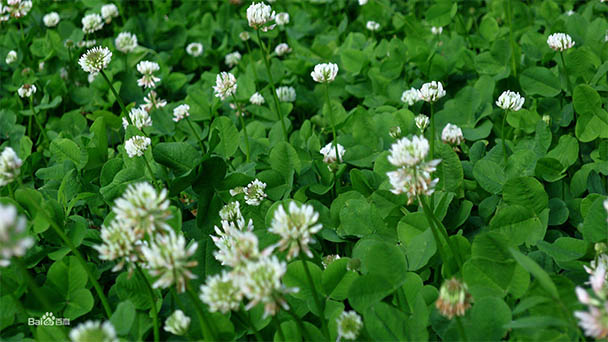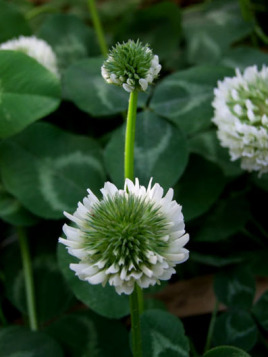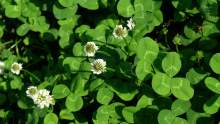Trifolium Repens L Profile
Written by LisaSmith
Nov 03 2020

Trifolium repens L is a perennial herb of the genus Trifolium repens in the leguminous family. It can be used for cultivation, and some weeds can invade dry crop fields and have certain influence on vegetables and young forests in some areas.
Trifolium Repens L Picture

Trifolium Repens L Morphological Characteristics
Its most obvious feature is the palm-like three compound leaves on the long petiole, and each leaflet has white lines, and the lines on the three leaflets together form an approximate triangle shape. The growth period of Trifolium Repens L can be as long as 6 years, and the height is 10-30 cm. Its flowering and fruit period is also very long, usually from April to October. Therefore, throughout the spring, summer and autumn, you can find small Trifolium Repens L's spherical flowers standing among the dense leaves.
Trifolium Repens L Growth Environment and Distribution
Trifolium Repens L is produced in Europe and North Africa. It has strong heat and cold resistance. It can grow vigorously in acidic soil or sandy soil. It has strong adaptability and is now widely distributed all over the world. It has certain ornamental value. In China, it is mainly used for grassland construction in gardens, and white three-leaf carpets woven by them can often be seen on wet grasslands, river banks and roadsides. It has good ecological and economic value.
Trifolium Repens L Efficacy
In addition to the uses mentioned above, Trifolium Repens L also has certain medicinal value. It is introduced in the Dictionary of Traditional Chinese Medicine that the whole Trifolium Repens L can be used as medicine. It has the effects of clearing heat and cooling blood, eliminating phlegm and relieving cough, and calming pain. Modern medical research has found that the soy saponins contained in Trifolium Repens L have a variety of pharmacological effects on the cardiovascular system, respiratory system, nervous system, as well as strengthening the body’s immunity and anti-tumor.
Cultivation method of Trifolium Repens L
1. Seeding
Trifolium Repens L can be sown in both spring and autumn. Trifolium Repens L is mixed with gramineous pastures such as ryegrass, orchardgrass, timothy grass, etc., suitable for establishing artificial grassland.
2. Weeding
After the Trifolium Repens L seedlings emerge, they will basically completely cover the ground, so it is difficult to apply mechanical weeding, and manual extraction methods are often used. Manual weeding was carried out 2 to 3 times that year to remove weeds and ensure growth. Generally, after mulching and weeding in the previous year, weeds only occur sporadically in the following years, basically eliminating weed damage.
3. Water management
Trifolium repens has strong drought resistance and poor waterlogging resistance. The growth is vigorous when the water is sufficient, water should be properly supplemented in drought, and waterlogging and waterlogging should be drained in time when there is too much rain to facilitate growth. Except for extreme drought conditions, watering is generally not required to avoid Pythium wilt. The watering of Trifolium Repens L should be based on the principle of less times and more quantity.
4. Fertilization
The Trifolium Repens L root system has nodules and has the ability to fix nitrogen. It requires less nitrogen fertilizer, but a small amount of nitrogen fertilizer is beneficial to strong seedlings. Because Trifolium Repens L nodule and root formation require more phosphorus and potassium nutrition, phosphate fertilizer and potassium fertilizer have a good effect on increasing production, and the fertilization of Trifolium Repens L is mainly phosphorus and potassium fertilizer.
5. Pest and Disease control of Trifolium Repens L
① Rod leaf disease
A type of disease caused by mycoplasma infection is common and serious in some areas. This disease causes plant leaves to be deformed, narrow and long, with irregular edges and nicks, and plant growth is weak, which affects the ornamental value. The disease can be spread through contact or insect mediators such as leafhoppers. The peak incidence is from July to August.
Control method: The disease should be managed well in the field, strengthen the disease resistance of the plant and control the vector.
②Dodder
Some areas are serious. The seeds of Cuscuta are very small and can be carried by Trifolium repens seeds. After germination, they become yellowish and parasitize on the stems and branches of Trifolium repens. They absorb their nutrients and water, resulting in lack of nutrients and yellowing of the plants. Growth is hindered, and death can occur in severe cases.
Prevention method:
1. Strengthen quarantine to prevent the spread of dodder seeds;
2. Manual cutting or plucking of infected plants, the key is to pluck or cut the dodder before fruiting to prevent its spread;
3. Chemical control: you can spray dinitro o-cresol and dinitrophenol for control.
③Leaf spot disease
Including a variety of fungal diseases, such as stolonifer leaf spot, coal spot, chitosan leaf spot, caudate streak and maculopathy. Among them, stolonifer wheel spot, coal spot and multicellular leaf spot are the most common, which produce various disease spots of different shapes, sizes, and colors on leaves, causing leaves to wither and fall off. Improper lawn management, vigorous plant growth, grassland canopy, poor drainage, and other serious diseases, hot and rainy summer and autumn are the peak of the disease, which can cause a large number of leaves to die and fall off.
Prevention and control methods:
control the occurrence of diseases by selecting disease-free seeds, removing diseased bodies, doing good management and protection, balanced fertilization, avoiding stagnant water, etc., and spraying carbendazim and thiophanate-methyl (thiophanate methyl) in a timely manner according to the condition ), mancozeb and other fungicides for prevention and control.
Knowledge Expansion-Lucky Trifolium Repens L
In China, the Trifolium Repens L has a legend - lucky four-leaf clover. Most Trifolium Repens L are palm-shaped with three compound leaves, but if you are lucky, you will find a four-leaf clover in the white flower clover. The probability of this happening is one in 100,000. If you find a four-leaf clover and take it off and carry it on your body, it will bring you good luck.
But after all, this is just a legend. Scientists have verified that this is just a common phenomenon. If you find a four-leaf clover in a piece of Trifolium Repens L, then there will be another four-leaf or even five leaves in this piece.
Latest Updated
- Benefits of Bugleweed - 7 Science-backed Health Benefits
- Bugleweed Dangers & Side Effects - Is It Poisonous?
- How to Plant Evergreen Trees - What You Should Know
- When to Plant Evergreens - Grow Guide for Evergreen Trees
- 12 Wonderful Evergreen Shrubs for Your Garden
- 12 Popular Evergreen Plants with Pictures for Beginners
- When And How To Prune A Lilac Bush Like a Pro
- How to Grow & Care for Lilac Vine (Hardenbergia Violacea)
- Japanese Lilac Tree (Syringa Reticulata) Care & Propagation Guide
- Shumard Oak Pros and Cons - What to Know
Popular Articles
- Winter maintenance of Antirrhinum Majus
- How to Grow Terminalia Mantaly Tree
- How to Grow and Care for Crossostephium Chinense
- How to grow Antirrhinum Majus in spring
- Peristeria Elata (Dove Orchid) Profile: Info & Care Guide
- Underwatered Snake Plant (Sansevieria Trifasciata) - Signs And How To Fix
- How to Care for Brazilian Jasmine Plant (Mandevilla Sanderi)
- How to Grow & Care for Graptopetalum Purple Delight in Summer
- Rosa Chinensis (China Rose): Plant Growing & Care Tips
- How to Care for Baby Sun Rose (Aptenia Cordifolia)
